-
Hey Guest one of our sponsors Progressive Parts is running Black Friday and Cyber Monday offers - more details here
You are using an out of date browser. It may not display this or other websites correctly.
You should upgrade or use an alternative browser.
You should upgrade or use an alternative browser.
Just dont blow your turbo up
Not something I plan on doing. But with my luck lately...............
Now try stall it whilst you've got your foot down on the throttle lol.
Remember, if an engine takes in a lot of oil and runs on it, it'd probably make more torque than the engine was ever designed for, hence snapped rods thrown through the block.
Air with a fine fuel mist can be compressed, but oil cannot. That is why a blown turbo that results in a runaway engine can cause bent rods. There's not much space when the piston is at the top of the cylinder -- add even a small quantity of engine oil and those piston rods will bend.
FWIW, catch cans or CCV filter systems were fairly popular on TDIs in North America a few years ago, but nobody bothers with them anymore. A little oil in the intake system doesn't hurt anything, as long as it doesn't get mixed with loads of soot. And soot is down because of ultra-low-sulfur fuel.
Last edited:
chapelhill
Guest
I thought that one of the reasons the catch can was used was to increase crank case ventilation so that under high boost there is less pressure build up in the crank case and therefore less likelyhodd of the turbo oil seals failing and taking out the turbo?
Why is it less popular and what is its main function now?
Thanks
Chapelhill
Why is it less popular and what is its main function now?
Thanks
Chapelhill
The crankcase ventilation (CCV) valve is more accurately described as a positive crankcase ventilation (PCV) valve. It is a one-way valve that releases gases from inside the crankcase.I thought that one of the reasons the catch can was used was to increase crank case ventilation so that under high boost there is less pressure build up in the crank case and therefore less likelyhodd of the turbo oil seals failing and taking out the turbo?
Why is it less popular and what is its main function now?
Thanks
Chapelhill
To borrow from Wikipedia:
"... due to the constant circulation of the oil within the engine, along with the high speed movement of the crankshaft, an oil mist is also passed through the PCV system and into the intake. The oil is then either burnt during combustion or settles along the intake tract, causing a gradual build-up of residue inside the inlet path. For this reason many engine tuners choose to replace the PCV system with an oil catch can and breather filter which vents the blow-by gases directly to atmosphere and retains the oil in a small tank (or returns it to the sump), although this technically fails to meet most engine emission legislation."
The oil itself, passing through the "intake track", is not harmful. But if there is a lot of soot being recirculated by the EGR system, the mix of soot and oil can clog up the intake. Cleaner-running diesel engines produce less soot, so there is less clogging, so less need to get rid of the oil via a catch-can or just a hose draining it to the ground.
Mines all in and working now and has been for a week or so.
It seems like the car runs smoother now although this may just be in my head, and my pipewrok is already getting cleaner inside I may however need to re-think the filter location as i currently have it on top of the catch tank but there is a smell of fumes inside the car sometimes so i may have to address that later on.
I may however need to re-think the filter location as i currently have it on top of the catch tank but there is a smell of fumes inside the car sometimes so i may have to address that later on.
But all in all its a brilliant mod i think.
Catch can: £9.99 posted (ebay win)
Hose: £2.00 halfords (will probably replace with silicone at some point)
Breather filter: £5.00
I cant use my engine cover anymore because of how ive run the pipework but i could easily change that, i thought i would run it with the cheaper hose and without the cover for a few weeks just to make sure it all stays secure and works well, and so far so good
Ill post pics later today.
It seems like the car runs smoother now although this may just be in my head, and my pipewrok is already getting cleaner inside
But all in all its a brilliant mod i think.
Catch can: £9.99 posted (ebay win)
Hose: £2.00 halfords (will probably replace with silicone at some point)
Breather filter: £5.00
I cant use my engine cover anymore because of how ive run the pipework but i could easily change that, i thought i would run it with the cheaper hose and without the cover for a few weeks just to make sure it all stays secure and works well, and so far so good
Ill post pics later today.
Im going to fit mine today, same as Ibiza Dan, using some hose I got hold of. Here is a picture of my can, added a clip here just looking at a way of securing it to a bracket in the engine bay.

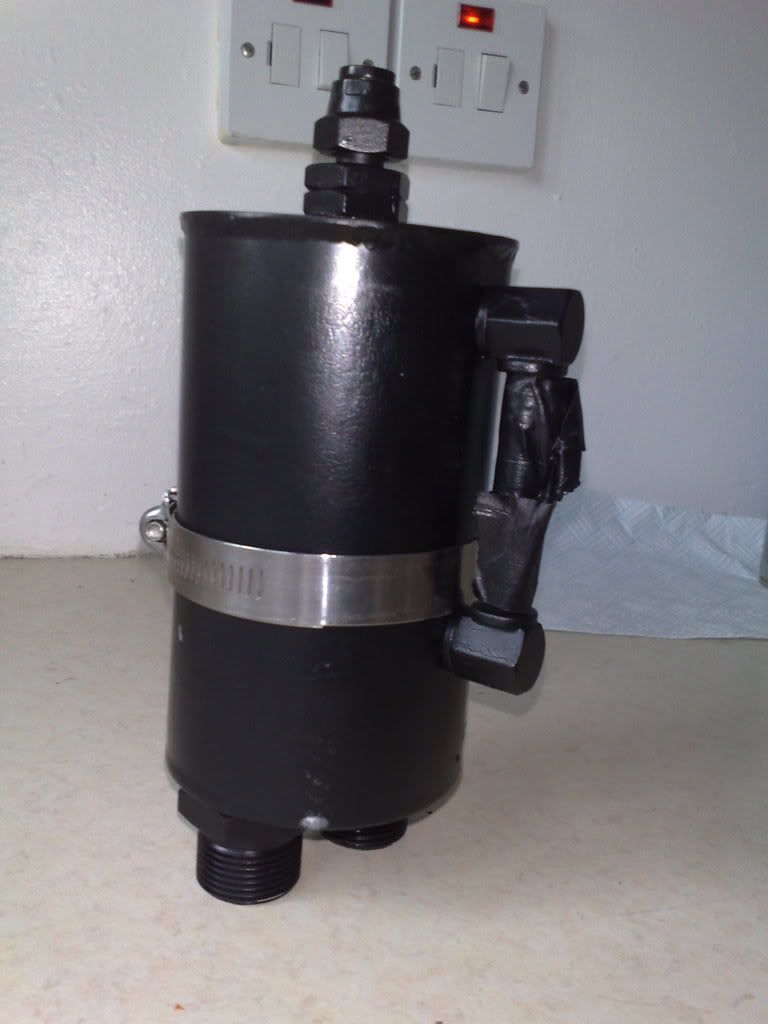
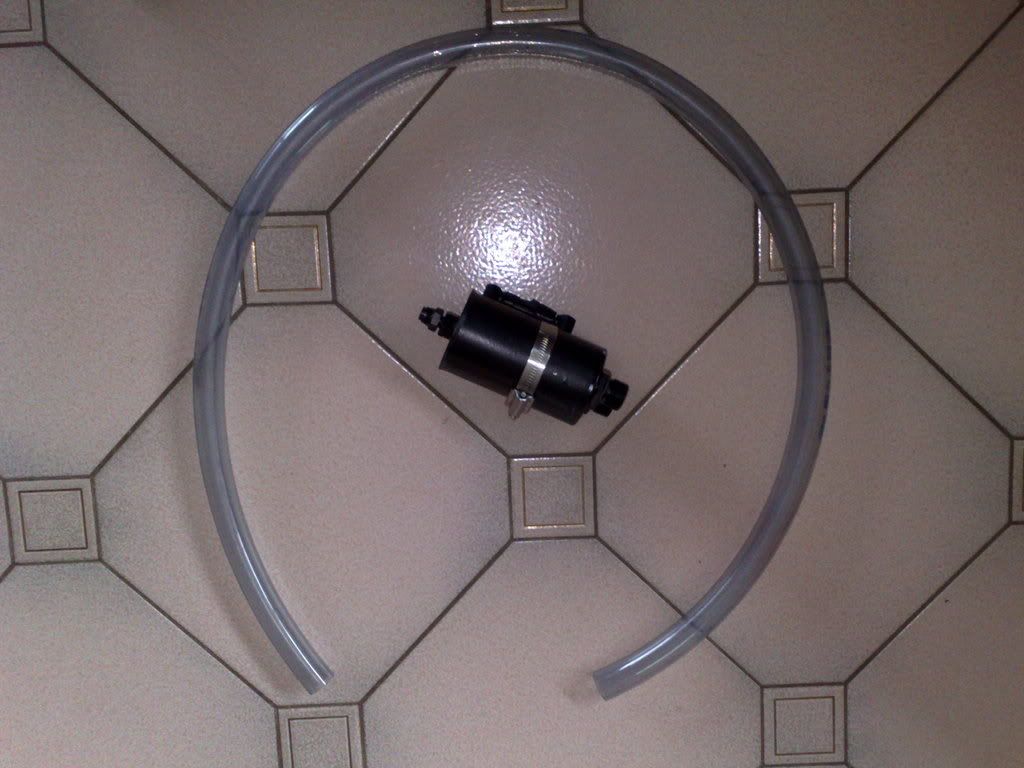
All homemade, needs bit of paint to finishe and black hose. But pretty good othere wise. Baffles inside to stop blow back of oil up hoses, drain point at bottom, Level guage on side (taped over) and inch diameter inlets so no problems with blockages.



All homemade, needs bit of paint to finishe and black hose. But pretty good othere wise. Baffles inside to stop blow back of oil up hoses, drain point at bottom, Level guage on side (taped over) and inch diameter inlets so no problems with blockages.
Pics of mine fitted on the bracket i made with my own hands 
Also i have a temp inlet blanking peice in at the moment, have a much better looking one to go on to finish the job
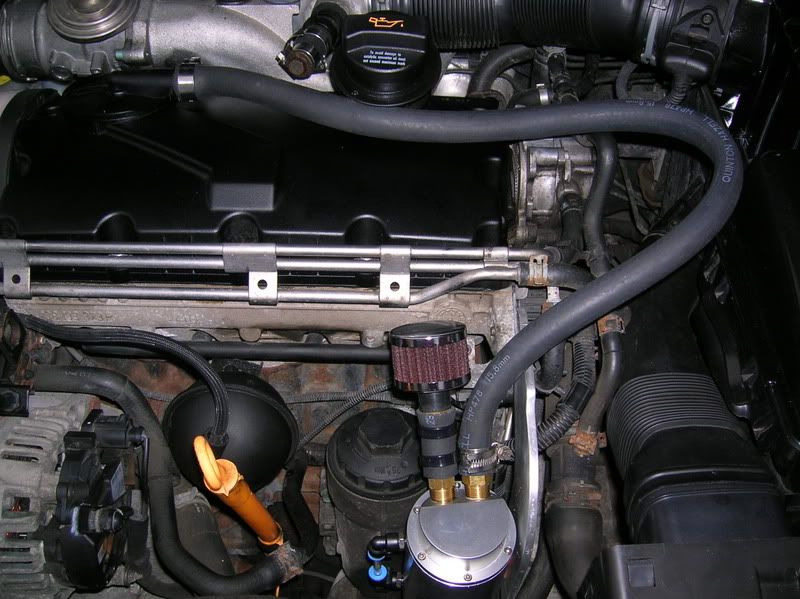
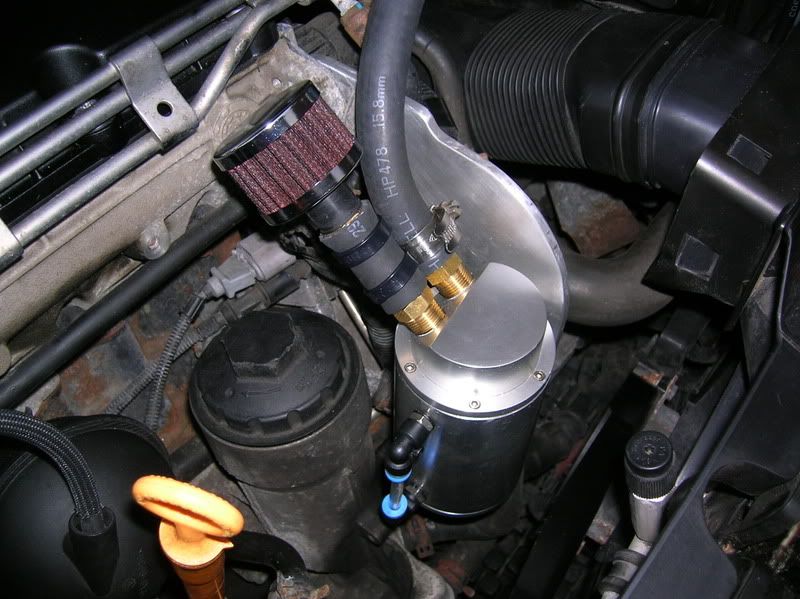
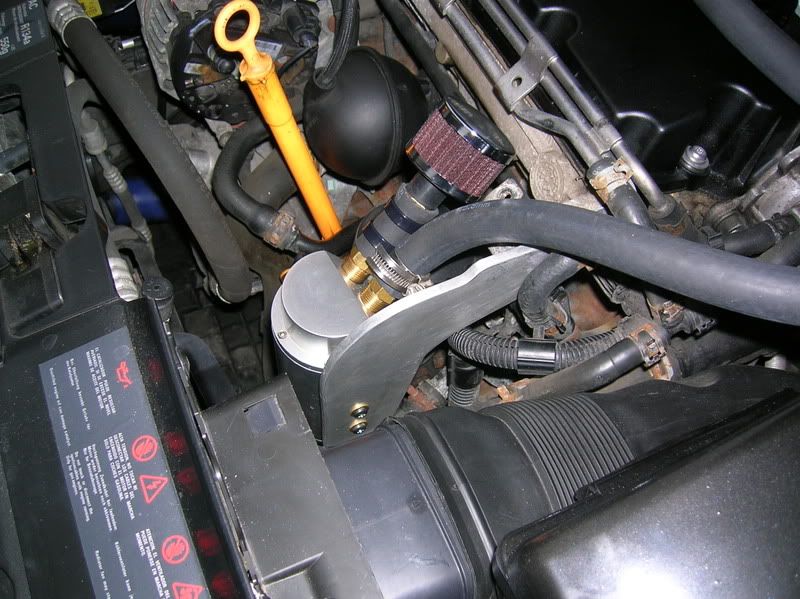
Also i have a temp inlet blanking peice in at the moment, have a much better looking one to go on to finish the job



Mines all in and working now and has been for a week or so.... my pipewrok is already getting cleaner inside.
Nothing wrong with clean dry intake pipes/hoses. I just don't think it's that important now, not like it was back when the fuel had more sulfur and soot was a bigger problem.
Putting your own system together, at low cost, sure beats buying a Mann-Hummel filtration unit and then buying replacement filters for it. It seems like only about three years ago that the Mann-Hummel was "the next big thing" in TDI improvements. Now they would be hard to give away.
will this actually catch any oil on a diesel, do you need them?
The catch cans or elephant hoses work, but it does not matter -- no need to get rid of the oil mist, it doesn't hurt a thing.
I am doing it as I seem to get a bit of residue throughout my piping. Only been on for around 12mile and see residue on inside, small amount, but still some none the less. I want clear piping and cut down on egr clogging for later on, want to keep the car for a while. Next will be the egr plate woth a hole to cut down egr volume. fuel here is a bit of a lottery too, get the dodgy homemade stuff at garages in certain areas here if your not carefull.
Oily crankcase fumes in the inlet charge are not ideal, but on their own would not cause too much difficulty.
However, downstream of the crankcase vent lies the EGR valve, an automotive kludge to comply with NOx regulations by injecting an inert gas into the inlet to reduce the oxygen content at the point where combustion temperatures might rise high enough to form NOx. This action increases the soot formation, and is the cause of the sooty blast you see from diesels accelerating away from the lights, or on joining the motorway.
The only convenient source of an inert gas is the exhaust (most of the oxygen is used up already) so hot sooty exhaust gas is added to oil-mist and crankcase vapours, forming a stiff sludge that bakes on, gradually chokes the inlet manifold and eventually stopping the EGR valve from closing when it should, triggering limp mode and much bad language.
CCV bypass (an oil catch can) is relatively easy to do and will reduce the sludge formation. EGR disabling is also easy to do, but recent cars will detect it as a fault and light the CEL.
TornadoRed, you are apparantly writing from the USA, where "low-sulphur" fuel was until recently 500ppm, much higher than European low-sulphur. However everyone is now moving on to ultra-low-sulphur, 15ppm or less, the US just a bit later than Europe.
However sulphur in fuel isn't responsible for soot, which is incompletely burned fuel, a result of poor engine management. Sulphur in diesel fuel interferes with particulate filter regeneration, which is why a move to low-sulphur fuel is required before any further reductions in particulate emission can be achieved.
However, downstream of the crankcase vent lies the EGR valve, an automotive kludge to comply with NOx regulations by injecting an inert gas into the inlet to reduce the oxygen content at the point where combustion temperatures might rise high enough to form NOx. This action increases the soot formation, and is the cause of the sooty blast you see from diesels accelerating away from the lights, or on joining the motorway.
The only convenient source of an inert gas is the exhaust (most of the oxygen is used up already) so hot sooty exhaust gas is added to oil-mist and crankcase vapours, forming a stiff sludge that bakes on, gradually chokes the inlet manifold and eventually stopping the EGR valve from closing when it should, triggering limp mode and much bad language.
CCV bypass (an oil catch can) is relatively easy to do and will reduce the sludge formation. EGR disabling is also easy to do, but recent cars will detect it as a fault and light the CEL.
TornadoRed, you are apparantly writing from the USA, where "low-sulphur" fuel was until recently 500ppm, much higher than European low-sulphur. However everyone is now moving on to ultra-low-sulphur, 15ppm or less, the US just a bit later than Europe.
However sulphur in fuel isn't responsible for soot, which is incompletely burned fuel, a result of poor engine management. Sulphur in diesel fuel interferes with particulate filter regeneration, which is why a move to low-sulphur fuel is required before any further reductions in particulate emission can be achieved.
Muttley: You are right that we just got better quality fuel in 2006 in all states... though some states had already mandated ULSD before then.
The reduced sulfur is only one aspect of improved fuel quality.
I am familiar with the problem of sludge accumulation in the EGR and the intake. But as I said, it is not the major problem that it used to be. Some folks are still having to clean their intakes, but not nearly as many as before.
If you want to do something to reduce or eliminate intake/EGR clogging, disable the EGR system. No recirculated sooty air, then no sooty oily sludge. Don't worry about the oil mist.
Finally, not all the oil that enters the intake system comes from the PCV -- the turbo seals are never so tight that they prevent oil from getting past, especially during long periods of idling. There are two sources for oil accumulating in the intake system -- a catch can or elephant hose only eliminates one of these sources.
The reduced sulfur is only one aspect of improved fuel quality.
I am familiar with the problem of sludge accumulation in the EGR and the intake. But as I said, it is not the major problem that it used to be. Some folks are still having to clean their intakes, but not nearly as many as before.
If you want to do something to reduce or eliminate intake/EGR clogging, disable the EGR system. No recirculated sooty air, then no sooty oily sludge. Don't worry about the oil mist.
Finally, not all the oil that enters the intake system comes from the PCV -- the turbo seals are never so tight that they prevent oil from getting past, especially during long periods of idling. There are two sources for oil accumulating in the intake system -- a catch can or elephant hose only eliminates one of these sources.
Hi everyone,
Aswell as the catch can i have also turned my EGR down via VAG-COM. I dont believe in removing the system completely as discused before, as it is part of the ASV system aswell. And i like the idea of my car having a fail safe system in place so it doesnt lunch itself if there is a probelm.
Hope you like my install by the way ?
Aswell as the catch can i have also turned my EGR down via VAG-COM. I dont believe in removing the system completely as discused before, as it is part of the ASV system aswell. And i like the idea of my car having a fail safe system in place so it doesnt lunch itself if there is a probelm.
Hope you like my install by the way ?
This is all new to me but won one on ebay last week like the pic below along with an Apiro air filter and some other bits, It is an alloy lightweight Rat Sport one, Won it all in for £13:50 



Similar threads
- Replies
- 13
- Views
- 644


